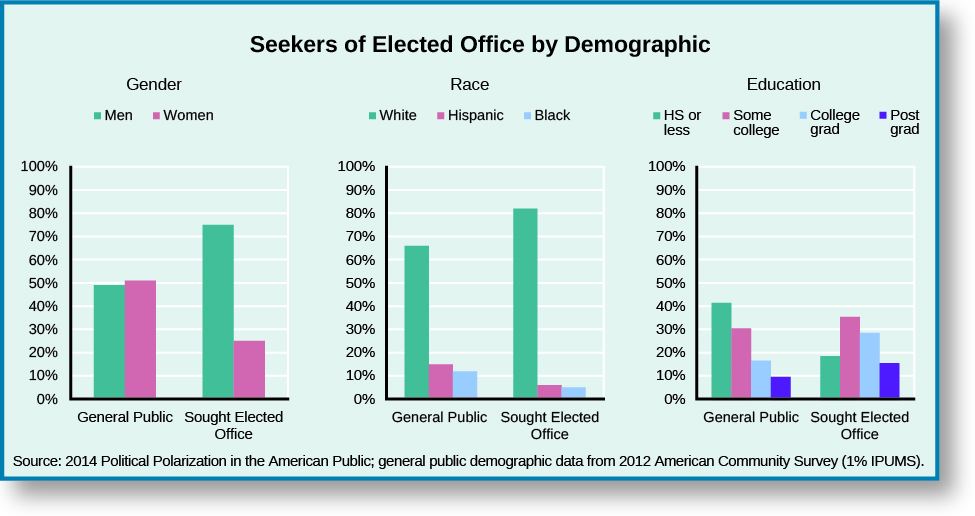DECIDING TO RUN
Running for office can be as easy as collecting one hundred signatures on a city election form or paying a registration fee of several thousand dollars to run for governor of a state. However, a potential candidate still needs to meet state-specific requirements covering length of residency, voting status, and age. Potential candidates must also consider competitors, family obligations, and the likelihood of drawing financial backing. His or her spouse, children, work history, health, financial history, and business dealings also become part of the media’s focus, along with many other personal details about the past. Candidates for office are slightly more diverse than the representatives serving in legislative and executive bodies, but the realities of elections drive many eligible and desirable candidates away from running.Jennifer L. Lawless. 2012. Becoming a Candidate: Political Ambition and the Decision to Run for Office. Cambridge: Cambridge University Press.
Despite these problems, most elections will have at least one candidate per party on the ballot. In states or districts where one party holds a supermajority, such as Georgia, candidates from the other party may be discouraged from running because they don’t think they have a chance to win.“Partisan Composition of State Houses,” http://ballotpedia.org/Partisan_composition_of_state_houses (November 4, 2015); Zach Holden. 20 November 2014. “No Contest: 36 Percent of 2014 State Legislative Races Offered No Choice,” https://www.followthemoney.org/research/blog/no-contest-36-percent-of-2014-state-legislative-races-offer-no-choice-blog/. Candidates are likely to be moving up from prior elected office or are professionals, like lawyers, who can take time away from work to campaign and serve in office.“Legislators’ Occupations in All States,” http://www.ncsl.org/research/about-state-legislatures/legislator-occupations-national-data.aspx (November 3, 2015).
When candidates run for office, they are most likely to choose local or state office first. For women, studies have shown that family obligations rather than desire or ambition account for this choice. Further, women are more likely than men to wait until their children are older before entering politics, and women say that they struggle to balance campaigning and their workload with parenthood.Jennifer L. Lawless and Richard L. Fox. 2010. It Still Takes a Candidate: Why Women Don’t Run for Office. Revised Edition. Cambridge: Cambridge University Press. Because higher office is often attained only after service in lower office, there are repercussions to women waiting so long. If they do decide to run for the U.S. House of Representatives or Senate, they are often older, and fewer in number, than their male colleagues (Figure). As of 2015, only 24.4 percent of state legislators and 20 percent of U.S. Congress members are women.“Women in State Legislatures for 2015,” 4 September 2015. http://www.ncsl.org/legislators-staff/legislators/womens-legislative-network/women-in-state-legislatures-for-2015.aspx. The number of women in executive office is often lower as well. It is thus no surprise that 80 percent of members of Congress are male, 90 percent have at least a bachelor’s degree, and their average age is sixty.Philip Bump, “The New Congress is 80 Percent White, 80 Percent Male and 92 Percent Christian,” Washington Post, 5 January 2015.

Another factor for potential candidates is whether the seat they are considering is competitive or open. A competitive seat describes a race where a challenger runs against the incumbent—the current office holder. An open seat is one whose incumbent is not running for reelection. Incumbents who run for reelection are very likely to win for a number of reasons, which are discussed later in this chapter. In fact, in the U.S. Congress, 95 percent of representatives and 82 percent of senators were reelected in 2014.“Reelection Rates Over the Years,”https://www.opensecrets.org/bigpicture/reelect.php (November 12, 2015). But when an incumbent retires, the seat is open and more candidates will run for that seat.
Many potential candidates will also decline to run if their opponent has a lot of money in a campaign war chest. War chests are campaign accounts registered with the Federal Election Commission, and candidates are allowed to keep earlier donations if they intend to run for office again. Incumbents and candidates trying to move from one office to another very often have money in their war chests. Those with early money are hard to beat because they have an easier time showing they are a viable candidate (one likely to win). They can woo potential donors, which brings in more donations and strengthens the campaign. A challenger who does not have money, name recognition, or another way to appear viable will have fewer campaign donations and will be less competitive against the incumbent.